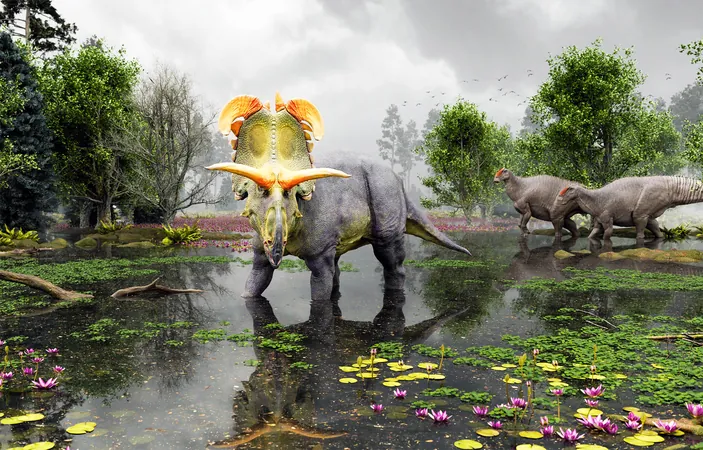
Meet Lokiceratops: The Most Ornate and Massive Horned Dinosaur Ever Discovered!
2025-05-30
Author: John Tan
A Stunning New Discovery in the Dinosaur World
Paleontologists have unveiled an extraordinary new species, Lokiceratops, a colossal horned dinosaur that roamed North America 78 million years ago. This remarkable creature was adorned with an extravagant frill and intricate, twisted horns, setting it apart from previously known dinosaurs.
Fossil Discovery Shifts Perceptions
The transformative finding of a partial skull in northern Montana is reshaping our understanding of dinosaur habitats. This unique ceratopsian fossil offers clues that North America's ancient ecosystems were more diverse and crowded than scientists had ever anticipated.
A Horned Titan Among Dinosaurs
Mark Loewen from the Natural History Museum of Utah and Joseph Sertich from the Smithsonian Tropical Research Institute meticulously reconstructed this skull from significant fragments. What they revealed was nothing short of groundbreaking.
They named the dinosaur Lokiceratops rangiformis, meaning 'Loki’s horned face that resembles a caribou.' The name reflects its striking appearance, reminiscent of a Norse god.
Unprecedented Fossil Findings
Lokiceratops, measuring approximately 22 feet long and weighing about 11,000 pounds, stands as the largest known centrosaurine. Its spectacular frill is adorned with sweeping, blade-like spikes and asymmetrical horns resembling twisted antlers—vastly different from its relatives that had typical short nose horns.
“These skull ornaments illustrate the biodiversity among horned dinosaurs and showcase how evolutionary selection for flamboyant displays contributed to the vibrant ecosystems of the Cretaceous,” Sertich noted.
Horned Indicators of Social Behavior
According to the research, Lokiceratops boasted the largest frill and horns of any ceratopsian to date, akin to a peacock's extravagant tail. Sertich suggested these impressive features were likely used for social signaling, helping dinosaurs distinguish between species and find mates.
Tightly Knit Dinosaur Communities
Fascinatingly, Lokiceratops cohabited with four other horned species in the same region, much like finding several types of modern rhinoceroses sharing a habitat. This challenges previous notions of how horned dinosaurs populated their environments in the Late Cretaceous.
Their limited geographic range along the Western Interior Seaway indicates strong local adaptations and possibly intense competition for resources.
A Glimpse into the Evolutionary Past
The discovery of Lokiceratops leads to fresh insights into the family tree of horned dinosaurs. By situating it among northern relatives, the study reveals how different species evolved unique traits in isolation over time.
The Importance of Lokiceratops
This discovery is invaluable for understanding evolutionary processes and demonstrates how social interactions can drive anatomical diversity, even in ancient giants. Lokiceratops serves as a portal into a past where dinosaurs inhabited tightly knit communities, contrasting sharply with the widespread herds of Triceratops that appeared later.
The fossil’s relocation to Denmark’s Museum of Evolution guarantees its preservation and continued study, emphasizing the importance of making such finds accessible to the public and researchers alike.
A Legacy of Wonder and Knowledge
Studying Lokiceratops allows scientists to explore the enigmatic evolutionary adaptations of ceratopsians under varying ecological pressures. This discovery not only expands our knowledge of dinosaur diversity but also underscores the value of preserving fossils in public domains for future research.
With Lokiceratops, we are reminded that nature’s artistry is timeless—celebrating beauty while navigating survival.
The findings have been detailed in the journal PeerJ, promising an exciting new chapter in the saga of prehistoric life.


 Brasil (PT)
Brasil (PT)
 Canada (EN)
Canada (EN)
 Chile (ES)
Chile (ES)
 Česko (CS)
Česko (CS)
 대한민국 (KO)
대한민국 (KO)
 España (ES)
España (ES)
 France (FR)
France (FR)
 Hong Kong (EN)
Hong Kong (EN)
 Italia (IT)
Italia (IT)
 日本 (JA)
日本 (JA)
 Magyarország (HU)
Magyarország (HU)
 Norge (NO)
Norge (NO)
 Polska (PL)
Polska (PL)
 Schweiz (DE)
Schweiz (DE)
 Singapore (EN)
Singapore (EN)
 Sverige (SV)
Sverige (SV)
 Suomi (FI)
Suomi (FI)
 Türkiye (TR)
Türkiye (TR)
 الإمارات العربية المتحدة (AR)
الإمارات العربية المتحدة (AR)